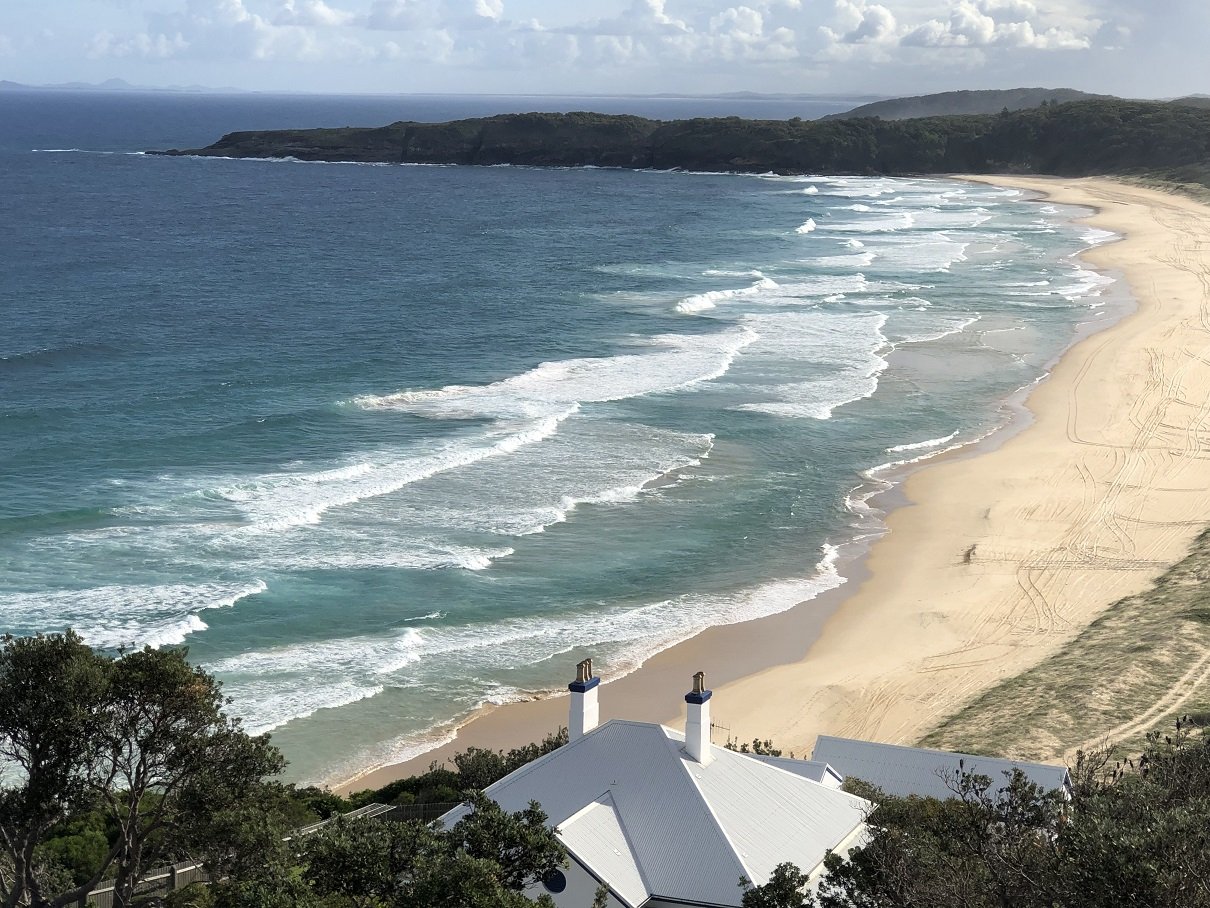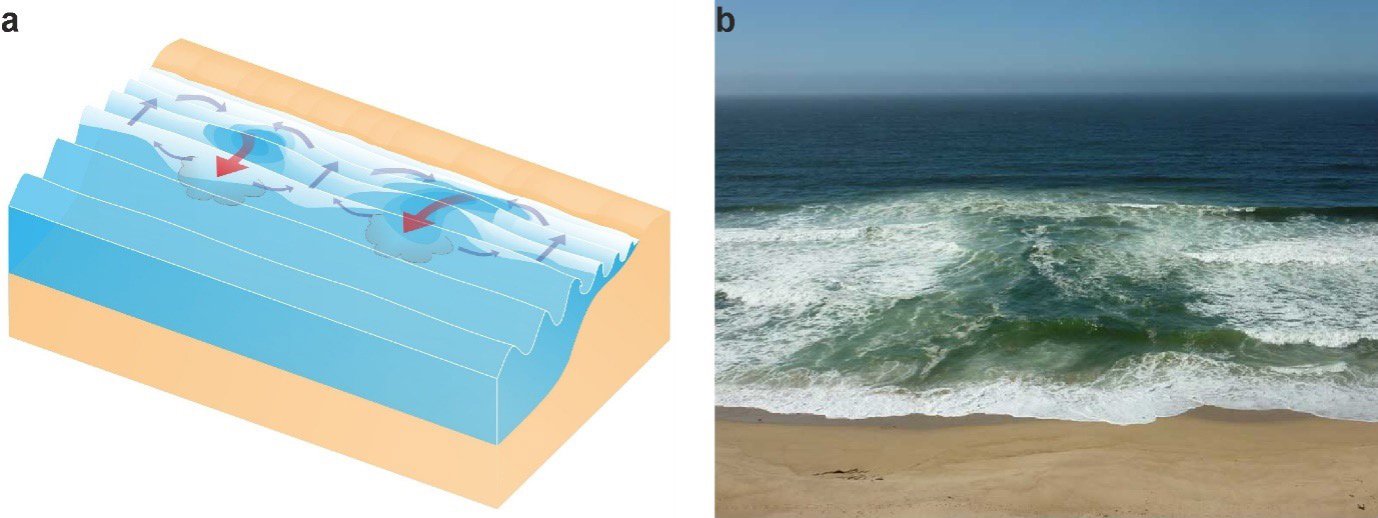
Types of Rip Currents
There are different types of rip currents that exist on beaches. Sometimes different types of rips can occur at the same time on the same beach and they often look and behave differently. So it’s important to know the differences between them, when and where they occur, and what they look like.
Channelised rip currents along Queensland’s Gold Coast (photo Jason Markland).
The 3 Most Common Types of Rips
Channelised Rips
(Lighthouse Beach, NSW, Australia - photo Rob Brander)
Boundary Rips
(Merry Beach, NSW, Australia - photo Mitch Harley)
Flash Rips
(Zuma Beach, California - photo LA County Fire Dept.)
There are many different names used to describe what are often the same kind of rip, which can be confusing sometimes. Several years ago, I worked with some excellent rip current scientists (and friends!) to come up with a classification of rip current types which was published in this scientific article:
We defined 3 main types of rip currents, each of which had sub-types based on the mechanisms that create spatial and temporal variability in wave breaking that leads to rip current flow. In total we defined 6 different types of rips and some of the Figures below come from this publication.
Bathymetrically Controlled Rip Currents
This is a fancy term for describing rips that are formed by variations in the underlying bathymetry, such as sand bars, that cause waves to break in different places.
Channelised Beach Rips (a, b)
Channelised rip currents form due to the presence of irregular patterns of nearshore morphology such as sand bars and channels. The rips occupy deeper channels between the sand bars and they can stay in place for days, weeks and even months. These are one of the most common types of rips and are the easiest to spot because of their tell tale ‘dark gap’ visual signature such as the rip at Marina Beach, California shown in (b) above. Channel rips can also erode mini-embayments along the shoreline as shown below.
Focused Rips (c, d)
Focused rips are not as common and are formed when the presence of an offshore topographic feature, such as a submarine ridge or canyon, causes incoming waves to bend (refract) and focus their energy and breaking in certain locations. This causes rips to form in fairly consistent locations over time that may be channelised or not. The example shown in (d) above is from Black’s Beach in San Diego, California (photo courtesy of Tom Cozad).
Channelised rip current embayment at Stanwell Park, NSW Australia
(photo Rob Brander)
Boundary Rip Currents
Many natural and artificial structures such as headlands, reefs, groynes, jetties and piers often have an almost permanent rip current flowing next to them and in some cases, on both sides. There are two main reasons for this. First, when waves approach the beach and break at an angle, they create an alongshore current that flows along the beach until it reaches an obstacle and is then deflected offshore. This is the deflection boundary rip shown on the right in the diagram below.
At the same time, waves approaching at an angle to a structure will focus wave energy and breaking further along the beach on the other side of the structure with a protected wave shadow zone immediately against it. This results in a water level gradient that drives flow back towards the structure and creates another rip heading offshore. This is the shadow boundary rip shown on the left in the diagram above. Both kinds of rips are often referred to as headland, structural or permanent rips. Most of these rips appear as dark gaps as they tend to occupy a deeper channel.
Boundary rip flowing alongside structure on the Gold Coast, QLD Australia (photo Jason Markland)
Boundary rip flowing against the headland at Tallows Beach, NSW, Australia (photo Rob Brander)
Hydrodynamically Controlled Rip Currents
These rip currents are not related to nearshore morphology or physical structures and are driven purely by hydrodynamics – waves and other currents. They tend to be variable in occurrence, both spatially and over time, which makes them hard to predict and they also don’t appear as dark gaps between white water. Instead they look like turbulent clouds and streaks of sand and water. There are several types of hydrodynamically controlled rips as shown below.
Flash Rips (a, b) and Shear Instability Rips (c, d)
Flash rips are common on beaches and as the name implies, they tend to form suddenly and don’t last long (a few minutes or less) before forming again somewhere else along the beach. The simple explanation is that some randomly large waves, or a set of large waves, will break causing the water level to rise quickly and create an offshore flow - a flash rip. As shown in (b) above of Zuma Beach, California, they appear as narrow bands of turbulent and sandy water heading offshore. They can initiate from the shoreline, but can also flow off the seaward slope of sandbars.
Rehoboth Beach, Delaware, USA - the flash rip is the whitewater heading offshore (photo Wendy Carey)
Coogee Beach, Sydney, NSW, Australia - the flash rip is the whitewater heading offshore (photo Rob Brander)
Shear instability rips are not common and only occur under specific conditions. When a very large swell wave event occurs and approaches the shoreline at a strong angle (as shown in (d) above at Huntington Beach, California) a very strong alongshore current is generated. As this current flows, different sections of the current move at different speeds – that’s where the ‘shear’ comes in. At some point this causes the current to become unstable resulting in eddy-like rips that spin out offshore like this one in Western Australia. Although they are not common, we’re seeing more images like this thanks to more drone coverage. They can flow fast enough to carry suspended sand from the breaking waves offshore.
Rip current eddy circulation at Rockingham Beach, WA, Australia (photo Scott Patman).
Other Types of Rip Currents
Mega Rips
These rips only occur on embayed (or pocket) beaches when waves are very large, such as during major storms. In these cases, massive mega rips can form along one or both headlands, or out from the middle of the beach, depending on the length and geometry of the embayment. These rips aren’t dangerous for people, because no-one would be swimming, but they can cause significant beach erosion
Mega rip during storm at Forresters Beach, NSW Australia (photo Andrew Short)
Swash Rips
The term ‘swash’ refers to the combined uprush and backwash when waves break at the shoreline. Swash rips are not technically rips, but they do involve the offshore flow of water, albeit not very far offshore. Most beaches that are very steep are characterised by features known as beach cusps. When waves break on these beaches the water rushes up the beach and the cusps act to concentrate the water in a very strong backwash, which can extend into deeper water. I often think the terminology ‘undertow’ may have originated with these types of rips.
Swash rips at Bells Beach, Victoria, Australia (photo Bruno Castelle)


















